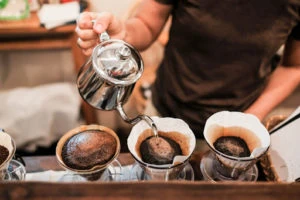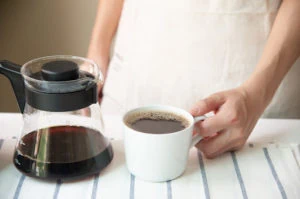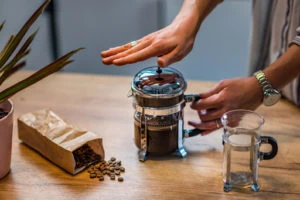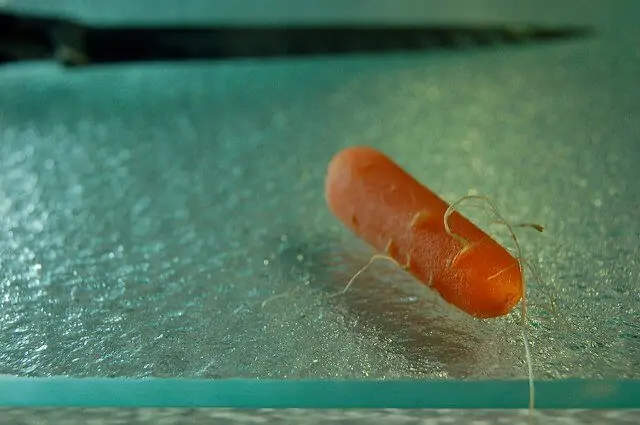
Traditionally, cutting boards have been made from a strong wood, often cherry, oak or bamboo.
With the introduction of plastic as a widely-used material around the late 19th century, many companies began to produce plastic chopping boards in mass production. Although wood remains the most common domestic cutting board material, plastic is widely-used, particularly in commercial settings.
More recently, glass cutting boards have started to become quite popular. Why do some people choose to use glass cutting boards, and are they safe?
Plastic and Wood Cutting Boards
The popularity of plastic or wooden cutting boards is self-evident. They are sturdy, won’t damage your knife and, in the case of wooden boards, look quite beautiful.
Personally, I have a few cutting boards and the primary ones are end-grain wood. They’re better for knives and it turns out that wood is sanitary if you care for it properly.
Check out the Totally Bamboo 3-Piece Bamboo Cutting Board Set at Amazon
The reason some would argue they are inferior to glass is they are harder to clean. Naturally, they pick up scratches and cuts from your knife.
Over time, water damage deepens them. This means bacteria can easily manifest within the grains, making wood and plastic boards potentially hazardous.
A cutting board that is not cared for sufficiently will crack and may also contain high levels of dangerous bacteria, especially when used for meat. Find out which cutting boards are best for meat.
You can easily mitigate these issues on wooden cutting boards, simply by treating them with oil. Oil treatments will slow the absorption of water and flavors of the foods, and therefore prevent damage. Learn which oils are good for cutting boards.
Glass Cutting Boards: Benefits
A glass cutting board does not pose the same threats as wooden or plastic ones, at least in terms of hygiene. They’re non-porous and therefore do not collect bacteria in the same way. Nor do they require the same upkeep.
They will not scratch or crack with water treatment, as they are generally treated for thermal shock. Plus, they are very easy to clean properly, reducing the threat of harmful bacteria.
Glass cutting boards are light and thin, making them easy to store away. They can be quite beautiful in their own right, as you can purchase them with all sorts of designs or pictures beneath the glass, giving you something nice to look at while you chop.
But I don’t like glass cutting boards at all. If you like glass cutting boards, I’m sorry. I’ll try to convince you.
Glass Cutting Boards: Potential Dangers
I get into more details below, but my #1 issue with glass cutting boards is that they will dull your knives. And it only takes a few minutes of cutting before your knife is noticeably dull. If you are thinking that you don’t have that problem, then it means your knives were already dull. You can test this by getting a new knife that’s sharp and you’ll see the performance degrade. (Don’t actually do this! Because then you’ll have a brand new knife that’s dull.)
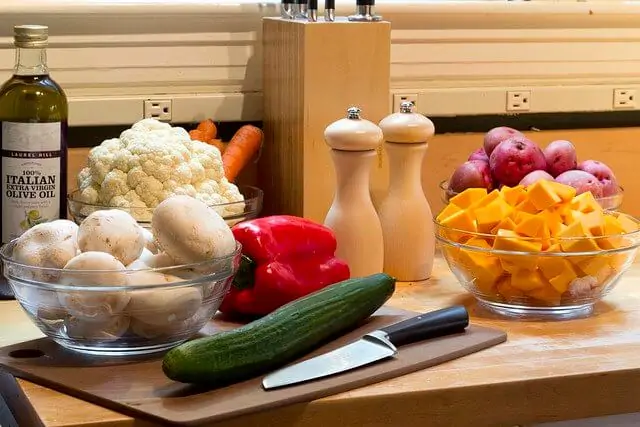
So what’s all the fuss about the safety of glass cutting boards? There are a number of reasons you could argue against the safety of them.
- Firstly, foods tend to slip around on a glass surface. This leaves a large amount of room for accidents to occur. If you’re cutting at a fast pace through a cucumber, the grip may give way, and you might cut a finger or two instead. The slippery surface of a wet piece of glass is not an ideal one for cutting with a sharp knife.
- Secondly, plastic cutting boards rarely come with rubber feet, meaning the glass base lies directly on your countertop. This means that the board is likely to move around under the pressure of your chopping. A moving cutting board is certainly not desirable, as it may lead to knife injuries, or even go flying off the countertop!
- Thirdly, glass doesn’t provide any “give” to the pressure of a knife in the same way a wooden or plastic model does. This lack of give will blunt your knives over time! As we all know, a blunt knife can actually be quite dangerous in the kitchen. Test whether your knives are sufficiently sharp with the methods described.
Read my knife sharpener buying guide for tips on maintaining the cutting edge of all your knives.
Blunt knives force you to be a little more reckless and forceful with the pressure you apply to the food you are cutting. Again, the wet surface of the board comes into play in this scenario. You don’t want to be forceful with a blunt knife on a wet surface. If you slip and cut your hand with a blunt knife, the damage is significantly worse than the damage caused by a sharp one, strange as that may sound. A blunt knife is still sharp enough to cut the surface, but it has a broader surface area, thus cutting a wider area of your hand.
Learn about all about knife edges to get an idea about how they work.
Recommendation
While a glass cutting board might seem like a convenient and easy piece of kitchenware to maintain and store, they are a potentially hazardous one. Glass is easy to clean and sanitize, but is slippery when wet, leaving you vulnerable to cutting yourself. They will also ruin your knives.
Consider using a wooden or composite cutting board instead. These models are much better for your knives, and your fingers!
You can see my reviews of the best cutting boards.
Cleaning cutting boards is simple. Here is what the USDA says:
To keep all cutting boards clean, the Hotline recommends washing them with hot, soapy water after each use; then rinse with clear water and air dry or pat dry with clean paper towels.
Both wooden and plastic cutting boards can be sanitized with a solution of 1 tablespoon of unscented, liquid chlorine bleach per gallon of water. Flood the surface with the bleach solution and allow it to stand for several minutes. Rinse with clear water and air dry or pat dry with clean paper towels.
Frequently Asked Questions
How can I remove mold on my cutting board?
As your cutting board is always in contact with food, you can try using a natural cleanser. If it’s very moldy, apply some sea salt on the board. You can use fresh lemon and salt on the surface of the board. The salt will remove stains and mold in the cracks, cuts, and grooves in the board and the lemon will leave a fresh smell. It’s very challenging to remove mold, so I would advise you not to be discouraged if the lemon and the salt don’t remove it all. If this doesn’t work, you can bleach it clean.
Bleach is a recommended disinfectant. It’s an excellent treatment of mold and they help keep cutting boards clean and free of harmful bacteria. For cleaning and removing mold, you can combine one teaspoon of bleach and two quarts of water. Dip a brush into the solution and use it to scrub the board, moving it in small circles to ensure that the solution gets into the grooves and cracks. You can use the solution sparingly when cleaning the butcher board or a wooden board.
If the molds become resistant, increase the ratio of the solution but don’t make it stronger. If the cracks and grooves are too thick and the bleaching is ineffective, then you can use fine grit to sand it down until you eliminate the mold. To avoid the board from getting moldy in the future, ensure that you dry the board properly with a towel after washing it. Allow it to air dry before storing it and clean it once in a week with white vinegar. You can use the sponge and let it rest on the board for about ten minutes before rinsing it. This will prevent the accumulation of mold in the future.
How are the bamboo boards treated?
Bamboo boards are split and treated using a high temperature. You create the caramelized color on it by repeatedly treating it at high temperature. Generally, no colors are added, but you apply mineral oil after making the board.
Why might there be mold on my dish rack?
Usually, mold forms on any organic, damp environment. The dish rack can have a protective finish, but as you use it for an extended period, it doesn’t provide the required protection compared with when it’s new. The mold on the dish rack can grow if it’s kept wet for an extended period. I would advise you to dry the rack after every use and avoid storing it in damp locations, such as under the sink.
Can I apply mineral oil to my board to prevent the growth of mold?
When treated with mineral oil, cutting boards stay much cleaner and safe from mold. I would advise you to soak a cloth with mineral oil and rub it on the surface of the cutting board. Apply a large amount of oil and let it soak in the wood for several hours. Wipe off the excess with a dry towel. Avoid using the vegetable oil and the olive oil, as it will turn rancid.
Do I have to oil my cutting board?
A cutting board that’s treated with oil is more hygienic since the bacteria cannot hide in the grooves and cracks. It helps in reducing the absorption of water. Also, the oil helps in improving the appearance of the cutting board.
Which is the best cutting board to purchase?
I would advise you to purchase a cutting board that is easy to clean, preferably a dishwasher-safe board. Also, choose a cutting board that won’t dull your knives Also get a board that’s lightweight, attractive, cheap, durable and resistant to the growth of bacteria. A cutting board made of wood is the most preferred, and it meets these qualities except that it’s not dishwasher safe. Some glass and plastic work well too.
What are the benefits of glass cutting boards compared with wooden boards?
The glass cutting board has some pros compared with the wooden and plastic ones. First, it doesn’t allow water to pass through (non-porous). As a result, mold cannot grow on the surface. It’s easy to maintain a glass cutting board, and it won’t scratch or crack when treated with water, as it’s usually treated for thermal shock. It’s easy to clean, which minimizes the threats that come with the growth of the bacteria. It’s thin, light and compact, making it easy to store in drawers and shelves. A glass cutting board can have an elegant design, giving you something unique to look when slicing or chopping your food.
How many cutting boards should I have in my kitchen?
You can have one cutting board if you want to clean it after every use. Otherwise, you can have two or three depending on what type of food you’ll be chopping. Some people prefer using the three different colors, i.e., white for baked goods, green for produce and red for meat. However, multiple cutting boards are essential if you have a lot of cutting activities. You can have separate cutting boards that you can identify easily by their colors or shape to save time and to maintain food safety when preparing meals.
How can I maintain my wooden cutting board?
I would advise you to rinse the board and dry with a towel after every use. Avoid soaking it in water since water will penetrate the cracks and grooves, leading to the growth of mold. I would advise you to oil it once per month when it appears dry. Also at this stage, avoid bleaching it since it will damage the antibacterial property of the wood.
A cutting board is the partner to your knives. See this post on the best knife set for my reviews of excellent models.

